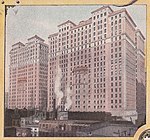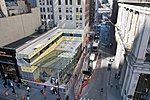2 World Trade Center
2010 architectureAC with 0 elementsBjarke Ingels buildingsBuildings and structures destroyed in the September 11 attacksBuildings and structures under construction in the United States ... and 6 more
Foster and Partners buildingsProposed buildings and structures in New York CityProposed skyscrapers in the United StatesSkyscraper office buildings in ManhattanUse mdy dates from April 2019World Trade Center
2 World Trade Center (also known as 200 Greenwich Street) is a planned skyscraper as part of the World Trade Center complex in Manhattan, New York City. It will replace the original 2 World Trade Center, which was completed in 1972 and subsequently destroyed during the September 11 attacks in 2001, and it will occupy the position of the original 5 World Trade Center. The foundation work was completed in 2013.
Excerpt from the Wikipedia article 2 World Trade Center (License: CC BY-SA 3.0, Authors).2 World Trade Center
Greenwich Street, New York Manhattan
Geographical coordinates (GPS) Address External links Nearby Places Show on map
Geographical coordinates (GPS)
| Latitude | Longitude |
|---|---|
| N 40.7121 ° | E -74.011 ° |
Address
2 World Trade Center
Greenwich Street 200
10048 New York, Manhattan
New York, United States
Open on Google Maps










